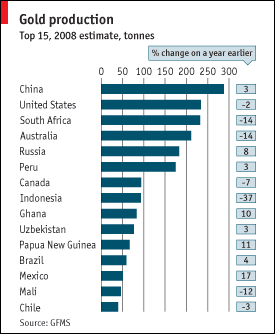– 39% Of South African Gold Production Is Now Offline (ZeroHedge, Sep 26, 2012):
Over a month ago, when discussing the implications of the South African miner strike that will not end until all local mining companies’ income statements are crippled after succumbing to wage hike demands, we said “Expect more South African mines to shutter, as gold production in the world’s third largest gold producer grinds to a halt, and the local workers grasp they had the leverage all along. Should the South African example spread to other countries, then expect the price of gold to soar regardless of how much printing the central planners engage in the coming weeks and month.” Today, we find out just what the final tally is , as this too prediction is proven correct: “Strikes at South African gold mines have shut about 39 percent of capacity, including at AngloGold (AGG) Ashanti Ltd. and Gold Fields Ltd. (GFI), as unofficial walkouts spread across the country in demand of above-inflation pay increases.” And boom: “AngloGold, the world’s third-largest gold producer, today said all of its South African mines have been halted. Gold Fields Ltd. also lost a metric ton, or about 32,000 ounces, of production after strikes at its KDC and Beatrix operations.” That’s ok, Bernanke will just print more gold.Nobody could have foreseen the complete collapse in South African mining production.
“Workers are now demanding wage increases according to the ‘Lonmin settlement’,” David Davis, an SBG Securities Ltd. gold analyst, said in a note. “Strike action may well spread from other mines to Harmony’s mines and to other industries.” Coal of Africa Ltd. (CZA) and transport workers have also been on strike.
Wage demands and direct action spread as workers sidelined traditional representatives for negotiating with management such as the National Union of Mineworkers, a backer of the governing political party. At Lonmin, workers appointed their own leaders. Julius Malema, expelled by the ruling African National Congress, has called for disruption and state control at mine operations.
Employees are gathering at the Bleskop stadium, where their appointed leaders will report back on a meeting with mine owners negotiated by the Commission for Conciliation, Mediation and Arbitration yesterday, the South African Press Association said.
Bernanke will only have to print 306,000 ounces to replace lost output (so far):
Anglo American Platinum (AMS), the largest producer of the metal, has lost about 20,000 ounces of output as workers refuse to report for duty at its Rustenburg operation, the company said today. The stock declined 4.4 percent in Johannesburg trade.
Impala Platinum Holdings Ltd. (IMP), the second-largest producer, raised pay to halt a six-week strike in January and February at Rustenburg, the largest mine producing the metal. Workers have since made new demands, Johannesburg-based Impala said Sept. 11.
More than 20,000 freight transport workers are also on strike, demanding a wage increase of 12 percent, SAPA said.
Harmony Gold Mining Co. said it’s unaffected by strikes.
AngloGold produced about 306,000 ounces in South Africa in the first quarter and Gold Fields’ KDC West and Beatrix about 212,200 ounces. The nation’s gold output was 1.35 million ounces in the quarter, the Chamber of Mines says. It was the fifth- biggest gold producing nation in 2010, according to GFMS Ltd.
As a reminder, South Africa is, well, was the world’s third largest producer of gold:
In other news, the strikes will continue until gold prices collapse completely due to zero supply and ever rising demand. Don’t ask – new normal math.
